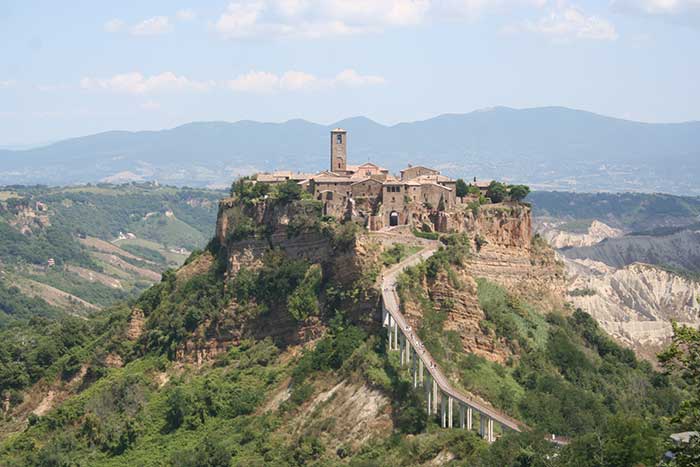Cività di Bagnoregio |
Civita di Bagnoregio, la città che muore located in a vast canyon atop a pinnacle ruled by wind and erosion. Perched on top of a hill among the valleys formed by Chiaro and Torbido streams, Civita appears clinged to the edge of a cliff where it dominates the wide desolated valley made up of calanchi. This isolation is the result of a continuous erosion that makes the tufa rock becoming thinner and thinner, the rock upon which Bagnoregio was built rests on layers of clay which over time tend to slip downwards, thus determining the collapse of sections of the rock above them. This explains why it is called il paese che muore, the dying town. |
||
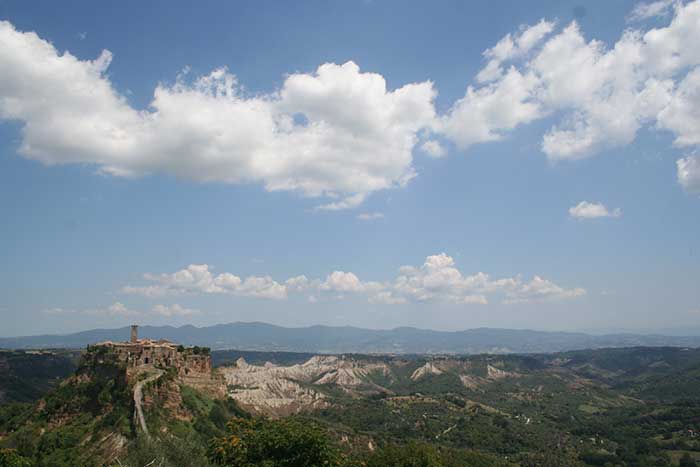 |
||
Civita di Bagnoregio is a magical place and poetically it’s known as the dying town. It was built built about 2,500 years ago by the Etruscans [1] . |
||
| The gate is also known as Porta del Cassero which indicates it was part of lost fortifications. The statues of lions holding a human head which decorate it are medieval representations of the Church and were usually placed at the entrance of a church. Lions and eagles were among the most popular iconographic symbols of the Classical World and they continued to be popular during the Middle Ages. Soon you will find yourself in Piazza San Donato or Piazza del Duomo. Nearby the Chiesa San Donato (8th century – the only church in town, built upon a pagan temple) there is a Romanesque bell tower or campanile (8th century) and the, now a government building. The church of San Donato was the cathedral of Bagnoregio until 1699, when this role was assigned to a new church built in the safer area where most of the inhabitants had moved. It has an elegant Renaissance façade while the interior is medieval. Near the church there is a wine cellar and an olive press that dates back to Etruscan times. |
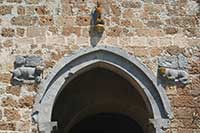 Civita di Bagnoregio, Porta S. Maria and the statues which decorate it. |
|
| Bagnoregio |
||
Bagnoregio is located between Orvieto and Bolsena, at the boundary of Latium. The Neolitic village was the abode of the Etruscan and Roman civilizations that gave it honour and fame. Some finds seem to testify that the first settlements date back actually to a pre-Etruscan age. In the past it was sacked several times, by the Visigoths, the Goths, the Longobards and the Bysantines. In 600 it was already a bishops seat. It rose from the ruins of a very old church, according to some historians it dates back actually to 440 and in the past was dedicated to the Madonna della Neve. Inside there is a XII century parchment bible, jealously kept, that probably belonged to San Bonaventura. |
||
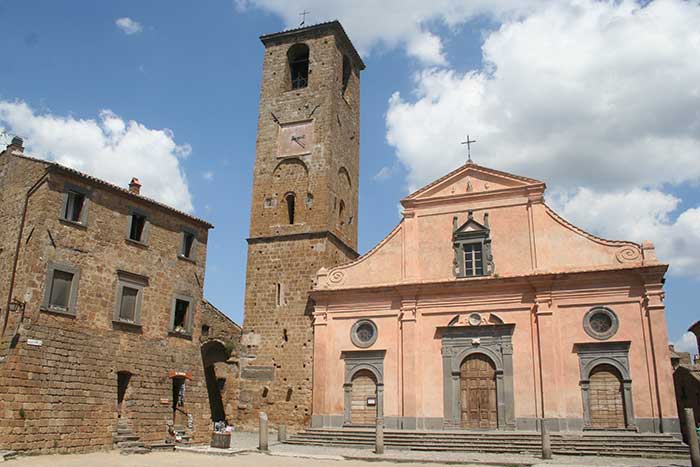 |
||
The church of San Donato, which overlooks the main square [1]
|
||
Civita di Bagnoregio hosts the Palio della Tonna (donkey races) on the first Sunday in June and the second Sunday of September.
|
||
The village of Lubriano is right on the border of Southern Umbria. As you enter Lubriano from the main road, (where all the tour buses stop to gaze across at Civita) there is a small square, protected by chestnut trees. There is a small fountain, an exellent view over the Calanchi valley, and a small war memorial in the middle. The square is called the Col di Lana, the Square of the Wool. The sheep from the valley were assembled here for shearing. Calanchi valley |
||
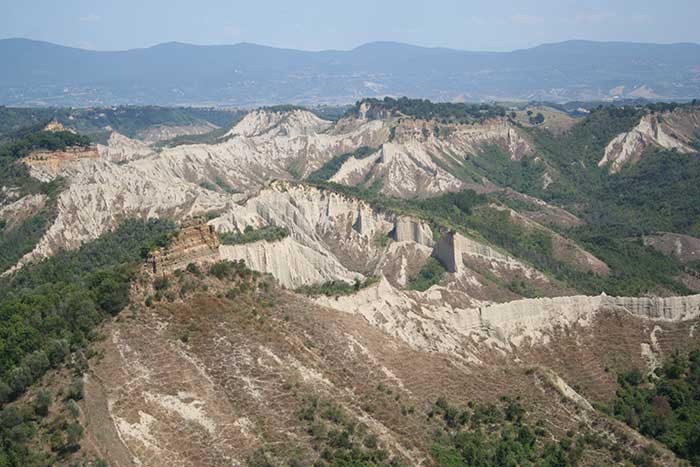 |
||
View from Civita Bagnoregio on Calanchi Valley [1]
|
||
Lazzaro Felice In 2018, Alice Rorhwacher filmed in the Valle dei Calanchi - Bagnoregio (Viterbo) Winner of Best Screenplay at 2018 Cannes Film Festival, Alice Rohrwacher’s Happy as Lazzaro follows the adventures of a man living on the margins of his society who can seemingly travel through time. Alice Rohrwacher's mesmerizing new film, takes place in a rugged landscape somewhere in central Italy. In a valley called Inviolata, a desolate land of semi-arid steppe, lonesome rims and mesas, rough hills and dunes, a clan of tireless (but not joyless!) sharecroppers live, love, and labor under the strident thumb of an unforgiving marquis. Lazzaro is a worker on the farm who dutifully follows every command given to him by the Marchioness, her son, Tancredi, and the estate manager.
|
||
Alice Rorhwacher, Lazzaro Felice, 2018
|
||
Channelling the spirit of Pasolini, Rohrwacher’s fascinating tale casts an ethereal, wondrous spell, and confirms her status as one of the most inventive and compelling voices in contemporary Italian cinema with this utterly transporting film experience [3].
|
||
Civita di Bagnoregio, Castel Cellesi en Vetriolo are part of Bagnoregio.
|
Enlarge map |
|
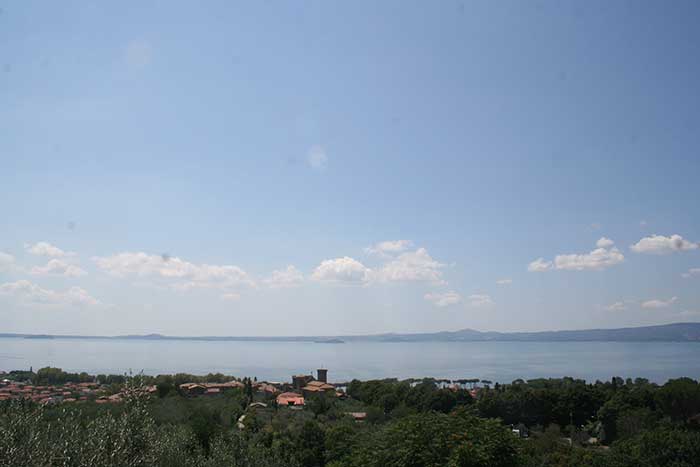 |
||
Bolsena Lake | Lago di Bolsena |
||
| Bolsena is crossed by Via Cassia, the ancient Roman road which during the Middle Ages became known as Via Francigena.
The stretch of Via Francigena from Bolsena to Montefiascone is a path that leads from Basilica of Santa Cristina in Bolsena (known for the miracle of Corpus Christi) to Rocca dei Papi in Montefiascone, for a total of about 18 km. The main part of the path goes through olive groves, hills and woods and goes over some parts of the ancient Via Cassia, with wonderful views of the lake. Upon arrival at the fortress Popes of Montefiascone you are greeted by a great 360 degrees view from the Tower of the Pilgrims: here you can see the gentle waters of Lake Bolsena VF - 37 - From Acquapendente to Bolsena | 22.1 km, 05:55 hours
VF - 38 - From Bolsena to Montefiascone | 18.3 km, 05:17 hours
Montefiascone |
||
| The Bisentina isle is an interesting touristic excursion for those people who go to Capodimonte on the Bolsena lake. Between the village and the isle there a ferryboat's service more than once a day on condition to have a minimum number of passengers. The etruscan and roman left a few traces of its permanence on the isle. In the IX century the coastal populations took to it to escape to the saracen's raids. In the middle of 1200 became property of the Bisenzio family who then burnt it out because of some disputes with the inhabitants. In 1261 Pope Urbano IV conquerred the isle again, in 1333 Ludovico il Bavaro, accused of heresy and excommunicated by the Pope, destroyed it again. From 1400 it was property of the Farnese family and it had a period of prosperity. It was visited by numerous Popes. In 1635 it was governed by Castro's duke Odoardo Farnese who went to clash to the church which ended with the fully Castro's destruction. After that, the Bisentina isle, like the Martana, went back to the church and then gived up. The princess Beatrice Spada Potenziani, wife of the duke Fieschi Ravaschieri, is the present proprietress. Le Meraviglie (Alice Rohrwachter, 2014) is a magical realist portrait of a family of beekeepers in rural Italy. The film, which stars Monica Bellucci, was shot in Sorano and other areas of the province of Grosseto, in the town Bagni San Filippo and on Isola Bisentina. Castello di Montecalvello |
||
| Montecalvello, which rises around a castle where the famous Balthus, a contemporary painter, lived for thirty years. Restored by Count Balthus Klossowski de Rola, the castle is beautifully maintained and still evolving .The studio of Balthus still has canvases on easels and a table where the artist worked. |
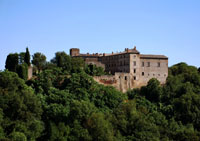 |
|
William Turner in Civita di Bagnoregio, 1828 |
||
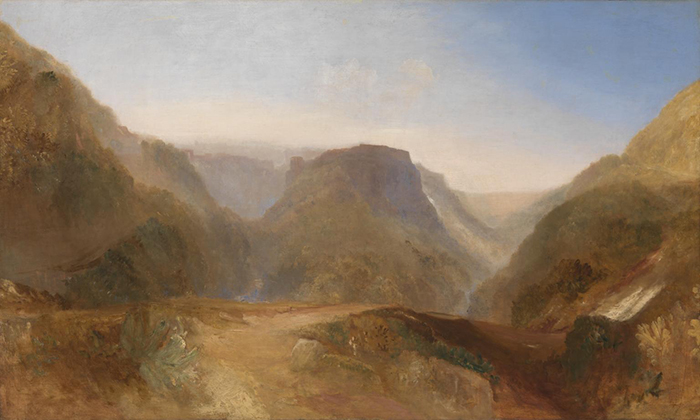 |
||
Joseph Mallord William Turner ‘Italian Landscape, probably Civita di Bagnoregio’, 1828 |
||
|
During his second trip to Rome in 1828, Turner spent some weeks painting in a studio, the first and only time he seems to have done so in a foreign country. This impressive, but unfinished, canvas appears to date from that period. Sketches documenting his route south between Florence and Rome suggest that the location is somewhere near the town of Orvieto, possibly Civita di Bagnoregio. There is a freshness and vitality about the lush green hills and distant waterfall, although the artist would have added a far greater level of detail to the work before declaring it complete.
|
||
|
||

